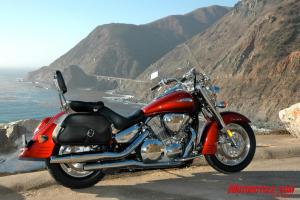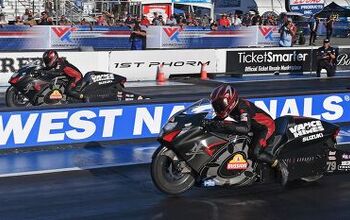2009 Honda VTX1300T Review - Motorcycle.com
Pity the metric cruiser rider. That was my thought as I pulled out of a gas station in Buellton, having filled the Honda VTX1300T. I shared a pump island with two husky, half-helmeted Harley riders who didn’t glance my way even once.
In the last few years, the cruiser world has been on a bigger-is-better kick, to the point where your bike needs to push the two-liter mark to give you any bragging rights at all. Little brother of the VTX1800, Honda’s $11,299 VTX1300T may therefore not be suitable for people with fragile egos.
That ‘T’ designation stands for ‘Touring’ marked by the addition of leather saddlebags, a passenger backrest, and a large windscreen. In my first week with the Honda, I rode from the teeming metropolis of Cardiff-by-the-Sea up to Laguna Seca, where I attended the AMA Superbike Championship’s Finale.
Locomotion is provided by a 1312cc V-Twin. It looks air-cooled at first glance, thanks to deep finning on the cylinders, but there’s a fairly small radiator there, too. A single cam resides in each head, actuating three valves (two intake, one exhaust) with twin-plugs in the heads. The 52-degree V-angle is far enough from Harley’s 45-degree single-crankpin setup that it doesn’t exactly say ‘potato-potato,’ but the VTX idles with its own pleasant rumble. It’s a Honda, so it’s fitted with civilized mufflers and balanced to within an inch (oops, I mean “a millimeter”) of its life. As I ran it up and down the rev range, there were only a few moments when the rigidly-mounted motor caused a faint resonance at the natural frequency of the footboards or seat. Never enough to be even least bit bothersome.
By traditional cruiser standards, it’s almost modern in that it’s got overhead cams and liquid cooling. And yet it’s still fitted with a single 38mm carburetor. How quickly I’ve forgotten the cool-morning rituals of pulling out a manual choke, and choosing between a too-fast idle or occasionally stalling. While the fit and finish is good, it’s devoid of niceties I’ve become accustomed to such as a tach or fuel gauge. Such features would be appreciated by the novice riders who will be attracted to the VTX for its relatively approachable price, mild manners, ease of maintenance, and low seat height.
My initial impression was that it felt heavy, although the low seat and formidable leverage afforded by the wide handlebar prevented that from being intimidating. At low speeds it has a tendency that I seem to notice in all raked-out bikes with a lot of steered mass; that the front wheel feels like it wants to fall over in tight parking lot maneuvers. Once underway in town, the handling improves as speeds get up above about 15 miles an hour. The bike also has a conspicuous tendency to follow road surface features, like some cracks and seams or the ‘ruts’ that develop in old pavement.
For my 5-foot-7 frame, the reach to bars was an inch too long, and the foot controls were a little far away, but for anyone of average height it would be right on the money. The mirrors are the best ones I’ve ever used on a motorcycle. There were one or two spots in the rev range where they vibrated slightly, but the rear view was usually crystal-clear.
The cable-operated clutch pull felt heavy, especially considering the relatively mild power output of the motor. The five-speed tranny met my expectations. I never missed a shift on this bike, which uses a heel-and-toe style shift lever. It engages first gear with a mighty (dare I say Harley-esque) clunk. The brakes were adequate. With just a single disc up front, using the rear brake is essential if you want to come to a quick stop.
Every bike seems to have its own natural speed on the freeway. For the VTX1300T, that’s about 70 miles an hour. At 70, the windshield keeps buffeting to a minimum. When the freeways aren’t flowing, that wide handlebar means that lane-splitting is really more of a theory than a practice.
The gas tank looked huge when I sat on the bike, so I was surprised to have to switch over to the reserve exactly 130 miles after filling it. (I got almost exactly 40 miles per gallon riding from North County San Diego to Ventura, up the 405 under good conditions.) The VTX is one of the few motorcycles I’ve ridden where the riding time between stops is limited by fuel tank range, and not my need to stretch my legs and re-caffeinate.
North of San Luis Obispo, on Highway 1, the VTX redeemed itself in ways that pleasantly surprised me. Although I didn’t want to ride much faster than 70 on the straight stretches, I hardly needed to slow down on the undulating coastline. The Dunlop tires provided more than enough grip to allow me to ground out the folding footboards (which don’t touch until the bike’s leaned pretty far over.) Using the footboards as indicators, I had quite a bit of fun catching and passing every single car I saw.
That’s obviously not the kind of riding that Honda had in mind for the VTX, but I’ll still note that the bike wallows a little in hard cornering. This phenomenon’s more noticeable in the higher speed bends, and obviously more pronounced if the surface is bumpy. The forks are not adjustable. The twin rear shocks are adjustable for preload, but I don’t get the feeling that I could’ve improved things much by reefing on the springs. In any case, I might’ve been feeling frame flex. That being said, this is a motorcycle that says, “Hey, relax. Don’t watch for cops, watch the scenery.”
Just before returning the bike, I took it to Area P for a dyno test. Proprietor Kerry Bryant actually had to move his dyno a few inches further from the wall to make room for the VTX’s locomotive-style wheelbase. Horsepower came in under 60 but it was the torque curve that had Kerry shaking his head in grudging admiration. “It’s already making about 90% of peak torque at the point where we start to record the run,” he noted. All that torque, available right off idle, makes the motor both novice-friendly and fun for more sporting riders.
Does the “Tourer” badge on the front fender really imply a touring bike? Or, is it merely a cruiser with a windshield and saddlebags? My conclusion is that the windshield, bags and fuel range only barely justify that claim. The bike’s redeemed by its steady motor, low-maintenance drivetrain, and better-than-average handling.
The Girlfriend tried the passenger accommodations and although I wouldn’t mind riding two hours up to Julian with her on the back I think we could just put enough stuff in the bags for one night at a B&B. If you call that touring, then it’s capable of touring. If your idea of touring involves camping in several time zones on the same vacation, you need to look at other bikes.
Buyers may choose the VTX because they think they’ll meet the nicest people on a Honda, but most will likely do so because it gives them something resembling a Harley-Davidson at a more affordable price. With an MSRP of $11,299, the VTX1300T’s closest real competitors are not made in Milwaukee. They’re more likely the Suzuki Boulevard C90T (1462cc, $11,699) or the Yamaha V-Star 1300 Tourer (1304cc, $11,290)
The charms of the VTX grew on me over time, and it would be a safe choice for low-key riders who fancy themselves to be Honda men (or Honda women, if they aren’t put off by heavy control inputs). It’s a competent cruiser with leather luggage that says, “Hey, I just might pack it all in and hit the open road.”
More by Mark Gardiner




































Comments
Join the conversation